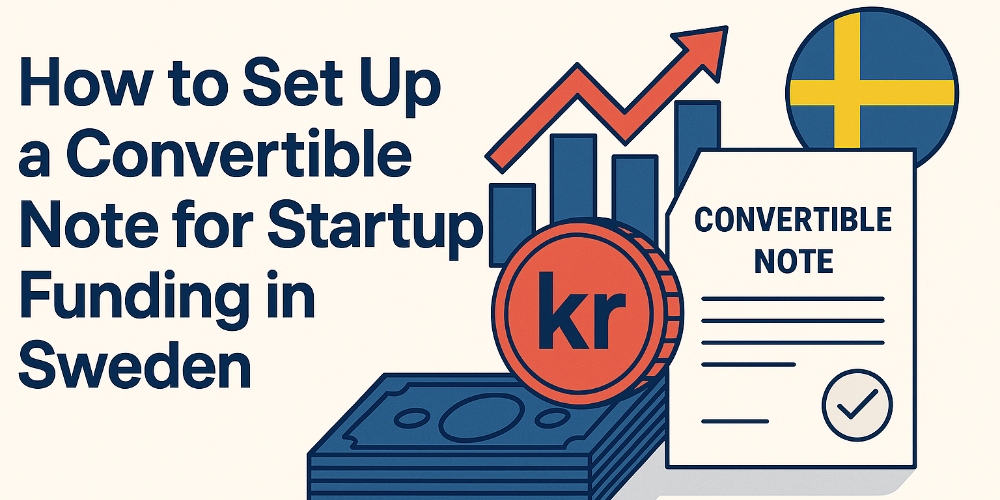Convertible notes are an increasingly popular tool for early-stage startup funding across Europe, and Sweden is no exception. Convertibles offer a fast and flexible way to raise capital without immediately pricing the company. However, to truly unlock their advantages, it’s crucial to structure them correctly. In this blog, we’ll walk through the essential elements of a well-designed convertible, especially in the Swedish context.

Why Convertibles Are Popular
Startups often use convertible notes to delay complex valuation negotiations until a later funding round. Convertibles convert into equity upon a triggering qualifying event, such as a future investment round. Convertibles have been in use by venture capitalists and early-stage investors for decades. A well-known form has been the Y Combinator SAFE note. Similar instruments like the Leapfunder Note are now widely used in Europe.
But not all convertibles are created equal, and a poorly structured one can expose both startups and investors to serious risks.
Ideally, Investors Should Never Have the Right to Reclaim Their Cash
That may sound a little draconian. But it is actually that important.
In the old days, some convertible note contracts allowed investors to reclaim their cash if they were not happy with the way things were going. That right could arise at the qualifying event for example, or when the convertible expired. It is rare that the startup has enough cash on its hands to repay its convertibles. So, giving this right to reclaim cash to investors was not safe. It often meant that at some point, the investors would have the power to bankrupt the startup, which now suddenly needed to pay them cash. Negotiating a conversion to shares with an investor, while that investor has the right to bankrupt the whole company is well… not a safe procedure.
So this was one of the reasons that the Y Combinator SAFE was developed. It doesn’t have a termination date, and doesn’t give the option of a cash reclaim upon the qualifying events. And so it is safe to use.
For the European market, the Leapfunder Note was set up around the same time. The Leapfunder Note gives the startups an irrevocable right to convert to shares. It just delays the moment when the final price of those shares is set. The Leapfunder Note provides lots of safeguards to make sure the eventual share conversion price is fair. That is what a convertible should always do. But one thing is clear: the investor has chosen to invest with the full equity risk. There is no way for the investor to back out. If either the startup or the investor wants to convert to shares, then it converts. That means there is never a situation in which an investor has a cash claim on the startup. And so it is safe to use.
A Consequence: A Modern Convertible Avoids the Swedish “Debt Trap”
In Sweden, companies must monitor their equity closely. At the time of writing, the law is that if they burn through 50% of their equity, they may be required to start procedures that basically prepare the company for liquidation. This is known as the “debt trap”. It means that funding through debt cannot get you away from mandatory liquidation procedures. The Swedish government is intending to abolish this rule, so check the news on this one.
Here’s the good news: a properly designed convertible note, with no cash repayment obligation, should be classified as equity for Swedish accounting, not debt. That means it strengthens your balance sheet and helps avoid triggering the debt trap. There’s no need to use exotic options or warrant structures. Simplicity and clarity win here.
Pooling Investors Is Essential
Early funding rounds often include many small investors. Without a pooling mechanism, every investor becomes a separate shareholder, which can create cap table chaos.
A good convertible includes a provision to pool investors into a single vehicle upon conversion. This keeps your cap table clean and makes your company more attractive for future funding rounds. Ideally, the vehicle is easy to set up and manage, doesn’t cause any additional tax burden for the investors, and maintains the essential rights of the investors.
Of course, a good investor pooling vehicle doesn’t make the smaller shareholders second-rank shareholders. Instead, the pool ensures that one formal signature is enough for the entire investor group, so that the startup doesn’t have to chase after a huge group of investors for their signature in every future transaction. At the same time, a good pooling structure ensures that the pooled investors collectively control what the pooling vehicle signs on their behalf, and of course, how the pool votes in the startup shareholders’ meetings. The purpose of the pool is to bundle the power of the smaller investors so they jointly have more influence, and at the same time to give them greater convenience. It should be a win for investors also.
In Sweden, we believe that a so-called Kommanditbolag is a good legal form for an investor pool. It is tax transparent, inexpensive to run, has limited liability, and it turns a larger group of investors into a single entity. The terms of the Kommanditbolag can be designed to ensure that investors’ rights to determine what happens to their investment are properly preserved.
Majority Rule Among Convertible Investors
It is rather common that convertibles need to be restructured before conversion. It may be that the startup proposes to extend the maturity of the convertible. Or that future investors want to change the investor pooling structure, for example. If a change in the conditions requires approval from each investor, even one holdout can block the process.
To avoid this, your convertible should include a majority rule mechanism even before conversion. This mechanism will be a contractual agreement that there is a way in which the investors to collectively make decisions about any restructuring, through a form of majority rule. This kind of decision-making fits with the spirit of the modern convertible: these investors are treated as shareholders from the beginning, and so joint decisions are made through a vote.
A Convertible Needs to Define Clear and Reasonable Qualifying Events
A key parameter of a convertible is its definition of the qualifying events. These are the events that trigger the conversion to shares. Ideally, not every equity issuance should trigger a conversion. In Europe, convertibles often run for a long time. If the startup decides to join an accelerator – and thereby gives away a % of shares in return for a small amount of cash and a lot of support services – then that share issuance should not be a qualifying event. If you had to convert at the low share price in one of those accelerator deals, then the founder might wind up losing a big part of their company. A convertible should only convert in the event of a real cash investment round.
A way to ensure that is to put in place a contractual minimum cash size for the investment that will trigger conversion, and to exclude in-kind contributions as a substitute for cash. Typical values for the minimum investment size that trigger conversion are:
- EUR 100K/ SEK 1 MIO in the Pre-Seed/Seed stage, or
- EUR 500K/ SEK 5 MIO for a convertible that is used as a bridge between VC tranches.
Although these values are usually fine, there can always be variations, of course.
Want a Full Checklist?
We’ve just scratched the surface. To go deeper, download the Convertible Note Checklist from Leapfunder — it walks you through other goodies, such as:
- How to handle end-of-term conversions
- How to define conversion share classes
- Whether you should define milestones
- And lots of other good stuff…
Final Thoughts
Setting up a good convertible note in Sweden isn’t difficult, but it has to be done right. Get the structure wrong, and you may end up in legal or financial trouble later. Get it right, and it can be the fastest path to secure and scalable early-stage funding.
At Leapfunder, we’ve helped hundreds of startups set up safe, investor-friendly convertibles. If you want guidance or templates tailored for Sweden, get in touch or sign up for one of our free training sessions.
Join our network of startups & investors!


